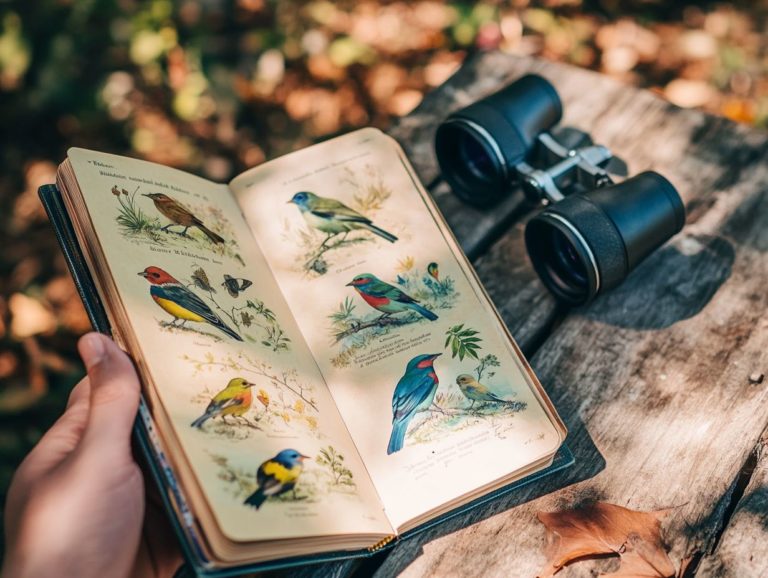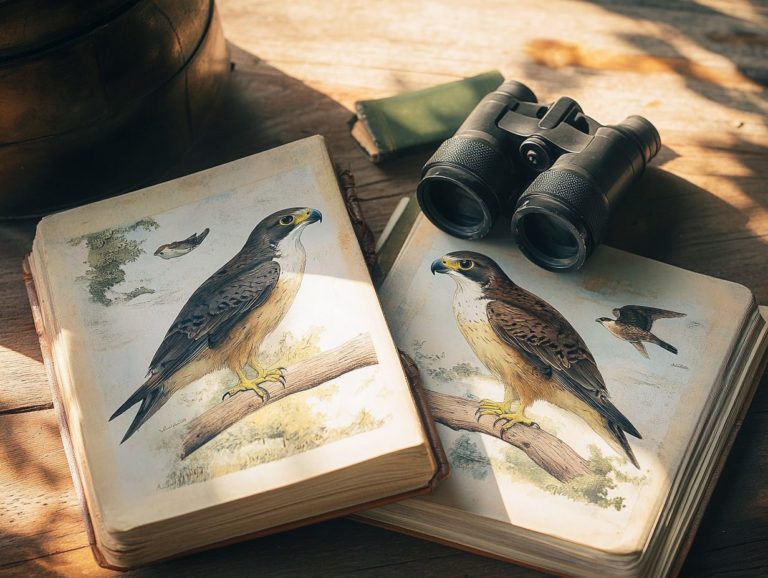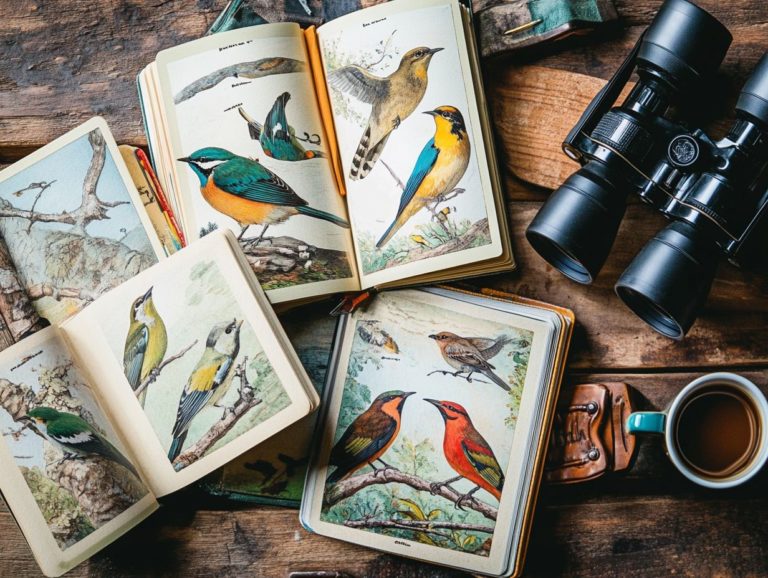How Field Guides Change the Birdwatching Game
Birdwatching has evolved from a casual hobby into a vibrant pursuit that captivates enthusiasts across generations, from casual birders to dedicated outdoor lovers! At the heart of this transformation lies the field guide an indispensable tool for both novice and seasoned birdwatchers. Guides like the Sibley guide and the Peterson field guide not only sharpen your identification skills but also enrich your understanding of avian life and the diverse wildlife species they represent.
In this exploration, you ll discover how field guides have revolutionized the birdwatching experience, the influence of technological advancements, and practical tips for selecting and utilizing these invaluable resources effectively on your birding expeditions. Prepare to delve into the dynamic relationship between birdwatching and field guides, elevating your appreciation for this fascinating pursuit while making cherished memories along the way!
Contents
- Key Takeaways:
- The Evolution of Birdwatching
- The Role of Field Guides in Birdwatching
- How Field Guides Have Changed Birdwatching
- Benefits of Using Field Guides
- Tips for Using Field Guides Effectively
- Frequently Asked Questions
- How do field guides enhance the birdwatching experience?
- What makes field guides an essential tool for birdwatchers?
- How have field guides evolved over time?
- What role do field guides play in conservation efforts?
- How do field guides benefit both beginner and experienced birdwatchers?
- What are some important features to consider when choosing a field guide?
Key Takeaways:

- Field guides have transformed birdwatching from a casual hobby to a serious pursuit, increasing interest and participation among those who track their sightings and maintain lists of the different bird species they have seen.
- Advancements in technology have made field guides more accessible and user-friendly, opening up birdwatching to a wider audience through resources like eBird and modern guides.
- Using field guides can greatly enhance identification skills and increase knowledge of bird species, making birdwatching more fulfilling and educational for both novice birders and seasoned enthusiasts.
The Evolution of Birdwatching
Birdwatching has transformed remarkably from a mere pastime into a serious endeavor, bolstered by technology, community engagement, and conservation initiatives. Once the domain of a dedicated few, this captivating activity now draws millions of outdoor enthusiasts throughout North America and beyond!
This surge in interest stems from an increasing awareness of wildlife species and the vital need for ecological preservation. In today s world, birdwatching serves not only as a source of relaxation and enjoyment but also plays a significant role in conservation efforts championed by organizations such as the American Birding Association.
From Hobby to Serious Pursuit
The transformation of birdwatching has truly redefined how you engage with this captivating hobby. As more people embrace this practice, you may find yourself diving into the intricate details of avian behavior and habitats, fostering a profound connection with the natural world.
This evolution has given rise to lists where birdwatchers keep track of the different bird species they have seen. Each tick on your list symbolizes not just a number, but a unique experience often shared with a vibrant community of fellow enthusiasts. Collecting these sightings allows you to reflect on your journey, underscoring the vital importance of conservation and awareness in your explorations!
The Role of Field Guides in Birdwatching
Field guides are essential companions in your birdwatching journey, equipping you with the necessary tools for accurate identification and enhancing your overall experience in the great outdoors. Whether you reach for the Peterson field guide or the Sibley guide, you’ll find these resources invaluable, no matter if you’re a novice or a seasoned birder.
With detailed illustrations and visual cues, they simplify the identification process for a diverse array of bird species across North America, making it enjoyable. Imagine the thrill of spotting a rare bird!
Join the birdwatching community today and discover the wonders of nature!
Definition and Purpose
Field guides are your best friends in birdwatching. These handy books and apps help you identify and learn about many bird species and their habitats.
They offer detailed descriptions, stunning illustrations, and informative maps that show bird behaviors and characteristics. With this knowledge, you can fully enjoy nature and appreciate wildlife.
Whether you’re watching a familiar robin or a rare warbler, having accurate information helps you connect with the ecosystem. These guides can also provide tips on where to find specific birds, making every outing a fun learning adventure!
How Field Guides Have Changed Birdwatching

Technology has transformed traditional field guides, allowing you to engage more deeply with birdwatching and understand bird behavior better.
With digital platforms like eBird and advanced apps, you have a wealth of information at your fingertips. You can document sightings, share experiences, and improve your identification skills in real-time!
Advancements in Technology
New technology, like field guide apps and platforms such as eBird, has changed how you access information. You can document your findings as they happen!
These tools help you immerse yourself in your surroundings and learn about different bird habitats. You can quickly identify species, understand their homes, and listen to their calls, all from your smartphone.
Community platforms allow you to share your observations, building a rich database that helps track migration patterns and bird behaviors. This connection fosters collaboration among birdwatchers, promoting avian conservation and education.
Technology makes birdwatching more accessible and interactive than ever. It enhances your personal experience and deepens your love for birds!
Impact on Birdwatching Community
Modern field guides and technology have greatly enriched your birdwatching experience, fostering collaboration among birders. You can connect with enthusiasts worldwide, exchanging sightings and advice in real time, thanks to the impact of technology on bird field guides.
Platforms like eBird let you log observations and share valuable data. This not only enhances your journey but also contributes to conservation efforts that protect wildlife habitats.
As you collaborate to identify bird behaviors and migrations, you play a vital role in protecting habitats and increasing awareness about endangered species.
Benefits of Using Field Guides
Using field guides in birdwatching provides many benefits. They improve your identification skills, expand your knowledge of bird species, and enrich your overall experience! Additionally, exploring how technology is changing bird watching can enhance your birdwatching adventures even further!
Enhancing Identification Skills
Field guides boost your bird identification skills. They provide essential visual cues and information about various species, transforming the task into an enjoyable pursuit.
Details on characteristics like color patterns, sizes, and markings help you recognize familiar birds. They also assist in identifying unique local species.
This newfound understanding deepens your appreciation for the remarkable diversity of avian life and the fragile ecosystems they inhabit. As you refine your skills using these guides, you become more attuned to the nuances of bird behavior and their environments.
Turning casual observations into enriching experiences fosters a profound connection to nature. This journey into the avian world nurtures your sense of environmental stewardship, inspiring you to champion conservation efforts that safeguard these extraordinary habitats.
Increasing Knowledge and Understanding

Utilizing field guides significantly enhances your knowledge and understanding of wildlife and nature. This fosters a deeper appreciation for avian diversity and the vital conservation efforts surrounding it.
These guides offer detailed insights into various species, their habitats, and behaviors. They serve as invaluable resources that inspire you to observe and respect the delicate balance of ecosystems.
As you immerse yourself in the nuances of birds’ calls, migratory patterns, and feeding habits, you cultivate a more comprehensive view of the environment. This newfound understanding instills a sense of responsibility, encouraging you to adopt sustainable practices.
Engaging with field guides not only elevates your personal enjoyment of birdwatching but also fosters ecological awareness within the broader community.
Tips for Using Field Guides Effectively
To truly enhance your birdwatching experience with field guides, consider referencing the most useful field guides for travel birding and adopt effective strategies for selecting the right guide and fully utilizing its features during your outings.
Choosing the Right Guide
Choosing the right field guide is essential for elevating your birdwatching experience. However, many birdwatchers are now transitioning from field guides to birding apps, which play a significant role in your ability to identify various bird species accurately.
As you consider which field guide to take on your outdoor excursions, several factors come into play. Your personal preferences matter do you lean toward a visually-rich guide filled with illustrations, or do you prefer one that provides detailed descriptions?
This choice can greatly influence your experience. Opting for a guide that focuses on region-specific content ensures you have the most relevant information for the areas you explore, making identification significantly easier.
Easy to use design is key; a well-designed guide should be easy to navigate, allowing for quick reference when you’re in the field. The right guide enhances your experience and deepens your appreciation for the vibrant avian world surrounding you.
Maximizing Field Guide Features
Maximizing the features of field guides, such as illustrations and identification systems, can significantly elevate your birdwatching game. By paying close attention to the details these guides offer, you’ll become more skilled at spotting the subtle differences in plumage, size, and behavior among various species. In the digital age, understanding the future of bird field guides can further enhance your experience.
Utilizing color-coded systems or organized sections can streamline your search process. This makes it much easier to compare similar birds. One effective tip is to familiarize yourself with the local avian residents before heading out; this foundational knowledge can boost your confidence and speed up your identification skills.
Leveraging beautifully rendered illustrations not only provides helpful visual cues but also enhances your understanding of the birds’ habitat preferences and behaviors. This enriches your overall experience in the field.
Frequently Asked Questions
How do field guides enhance the birdwatching experience?

Field guides provide detailed information about different bird species, their behavior, and habitats. This makes it easier for birdwatchers to identify and locate birds in the wild.
What makes field guides an essential tool for birdwatchers?
Field guides offer valuable information on bird identification and distribution. They also cover migration patterns, helping birdwatchers plan their trips and increase their chances of spotting specific bird species.
How have field guides evolved over time?
Field guides have evolved from simple hand-drawn illustrations to detailed color photographs and digital versions. This progress offers birdwatchers valuable insights on how to use a field guide for bird watching, providing more accurate and up-to-date information.
What role do field guides play in conservation efforts?
Field guides help birdwatchers identify endangered or threatened bird species. They raise awareness and promote conservation efforts to protect these valuable creatures.
How do field guides benefit both beginner and experienced birdwatchers?
Field guides meet the needs of both beginners and experienced birdwatchers. They provide detailed information for beginners and serve as a quick reference for experienced birders.
What are some important features to consider when choosing a field guide?
When choosing a field guide, consider its size and portability. Also, look for the level of detail and accuracy, and whether it covers the specific region or type of birds you are interested in.
Don t miss out on the chance to identify amazing birds! Grab your field guide today and start your birdwatching adventure!






